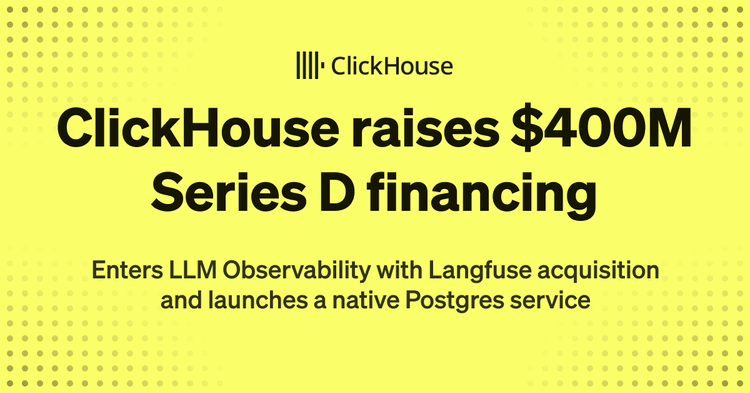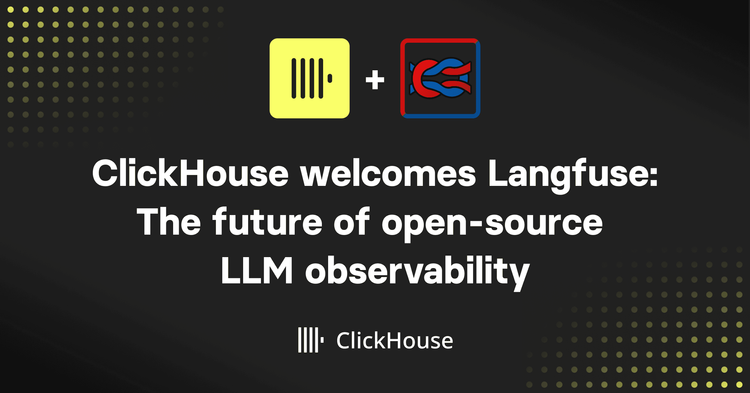In the world of data analysis, Pandas is considered the starting point for most Python-based data exploration. But what if we want to query our DataFrames using an OLAP database like ClickHouse to take advantage of its query engine and SQL support?
This is where chDB, a Python library powered by ClickHouse, comes into play. We’ve already featured chDB a couple of times already on the blog, but in this post we’re going to focus on its ability to query Pandas DataFrames, join them together, aggregate data, and then export the results back to Pandas.
chDB is available via PyPi, which means we can install it with pip:
pip install chdb
We’ll also need to install Pandas and PyArrow as the DataFrame functionality of chDB has dependencies on those libraries:
pip install pandas pyarrow
Ok, now we’re good to go. We’re going to explore Kaggle’s Canadian house prices for top cities Dataset, which contains real estate data from the 2021 census.
Once we’ve downloaded the CSV file, we’re going to read it into a Pandas DataFrame.
import pandas as pd
house_prices = pd.read_csv(
filepath_or_buffer="data/HouseListings-Top45Cities-10292023-kaggle.csv",
encoding = "ISO-8859-1"
)
And then we can have a look at a couple of the records:
house_prices.head(n=2).T
0 1
City Toronto Toronto
Price 779900.0 799999.0
Address #318 -20 SOUTHPORT ST #818 -60 SOUTHPORT ST
Number_Beds 3 3
Number_Baths 2 1
Province Ontario Ontario
Population 5647656 5647656
Latitude 43.7417 43.7417
Longitude -79.3733 -79.3733
Median_Family_Income 97000.0 97000.0
Querying DataFrames with ClickHouse #
To query a DataFrame in chDB, we need to import the chdb.dataframe module:
import chdb.dataframe as cdf
This module has a function called query that we can use. We can pass in 1 or more DataFrames as named parameters, which we can then address in the query. The parameter names that we use can be addressed as __<parameter-name>__. The following query finds the top 10 cities with the most properties:
cdf.query(
house_prices=house_prices,
sql="""
FROM __house_prices__
SELECT City, Province, count(*)
GROUP BY ALL
LIMIT 10
""")
City Province count()
b'White Rock' b'British Columbia' 1175
b'Toronto' b'Ontario' 1276
b'Kelowna' b'British Columbia' 1280
b'Winnipeg' b'Manitoba' 530
b'Winnipeg' b'Ontario' 1
b'Red Deer' b'Alberta' 326
b'Thunder Bay' b'Ontario' 154
b'Lethbridge' b'Alberta' 379
b'St. Catharines' b'Ontario' 1268
b'Trois-Rivieres' b'Quebec' 165
Joining DataFrames with ClickHouse #
As well as querying individual DataFrames, we can also join them together. So we’re going to bring in another dataset that contains metadata about Canadian cities. Let’s have a look at that one:
cities = pd.read_csv(
filepath_or_buffer="data/canadacities.csv"
)
cities.head(n=1).T
0
city Toronto
city_ascii Toronto
province_id ON
province_name Ontario
lat 43.7417
lng -79.3733
population 5647656.0
density 4427.8
timezone America/Toronto
ranking 1
postal M5T M5V M5P M5S M5R M5E M5G M5A M5C M5B M5M M5...
id 1124279679
We can join this DataFrame with the first one via the city_ascii and province_name fields.
top_cities = cdf.query(
house_prices=house_prices,
cities=cities,
sql="""
FROM __house_prices__ AS hp
JOIN __cities__ AS c
ON c.city_ascii = hp.City AND c.province_name = hp.Province
SELECT City, Province, count(*),
round(avg(Price)) AS avgPrice,
round(max(Price)) AS maxPrice,
ranking, density
GROUP BY ALL
LIMIT 10
""")
If we view the top_cities variable, we’ll see similar to the following:
City Province count() avgPrice maxPrice ranking density
b'Brantford' b'Ontario' 628 955923.0 6495000.0 2 1061.2
b'Hamilton' b'Ontario' 1289 975543.0 10995000.0 2 509.1
b'Thunder Bay' b'Ontario' 154 459703.0 5599000.0 2 332.1
b'Caledon' b'Ontario' 1336 1383366.0 9995000.0 3 111.2
b'Calgary' b'Alberta' 1322 660046.0 5250000.0 1 1592.4
b'Windsor' b'Ontario' 720 643019.0 2750000.0 2 1572.8
b'Medicine Hat' b'Alberta' 277 448137.0 1475000.0 3 565.1
b'Montreal' b'Quebec' 212 931392.0 4400000.0 1 4833.5
b'Edmonton' b'Alberta' 1351 425582.0 4463445.0 1 1320.4
b'Sudbury' b'Ontario' 203 596087.0 7699900.0 2 52.1
top_cities has the type <class 'chdb.dataframe.query.Table'> and we can actually query chDB tables using SQL as well. We can do this using the query function where the underlying table is accessible as __table__ .
So, if we wanted to get the first 5 rows of top_cities, we could write the following:
top_cities.query("""
FROM __table__
SELECT City, maxPrice, ranking, density
LIMIT 5
""")
City maxPrice ranking density
b'Brantford' 6495000.0 2 1061.2
b'Hamilton' 10995000.0 2 509.1
b'Thunder Bay' 5599000.0 2 332.1
b'Caledon' 9995000.0 3 111.2
b'Calgary' 5250000.0 1 1592.4
Exporting chDB Tables to Pandas DataFrames #
And if we’ve done enough querying with ClickHouse, we can always convert that table back to a Pandas DataFrame using the to_pandas function:
top_cities_df = top_cities.to_pandas()
And let’s do a bit of querying in Pandas to finish off:
(top_cities_df[top_cities_df["Province"] == b"Ontario"]
.sort_values(["ranking", "density"])
.drop(["Province"], axis=1)
)
City count() avgPrice maxPrice ranking density
b'Sudbury' 203 596087.0 7699900.0 2 52.1
b'Thunder Bay' 154 459703.0 5599000.0 2 332.1
b'Hamilton' 1289 975543.0 10995000.0 2 509.1
b'Brantford' 628 955923.0 6495000.0 2 1061.2
b'Windsor' 720 643019.0 2750000.0 2 1572.8
b'Caledon' 1336 1383366.0 9995000.0 3 111.2
In Conclusion #
chDB is constantly evolving, but what it can already do is pretty cool. So head over to the GitHub page and give it a try!



